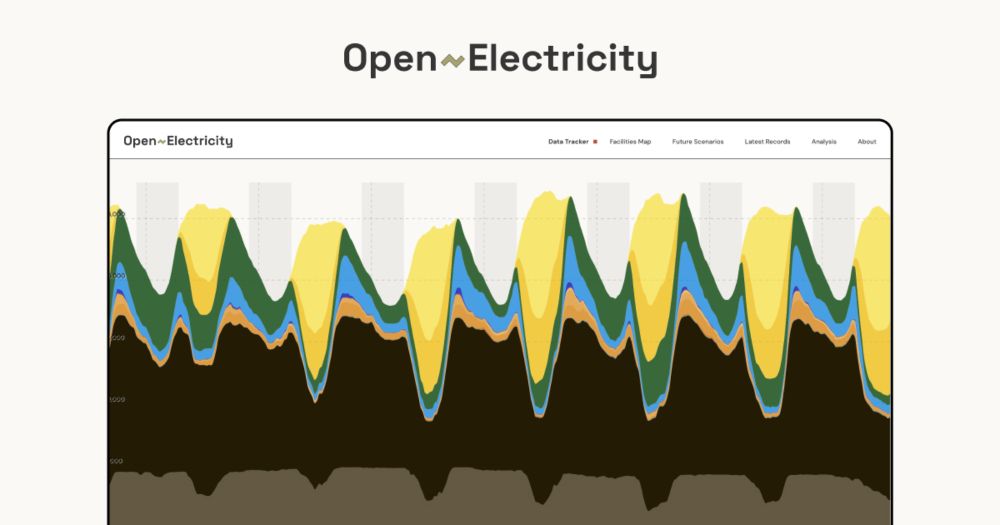
Open call for papers, Energy Markets and the Macroeconomy Conference. Meeting to be held in Cambridge on December 10–11, 2026. Submit papers by 11:59pm EDT on November 19, 2025. More information: https://www.nber.org/calls-papers-and-proposals/energy-markets-and-macroeconomy-conference
22.09.2025 21:00 — 👍 4 🔁 3 💬 0 📌 1
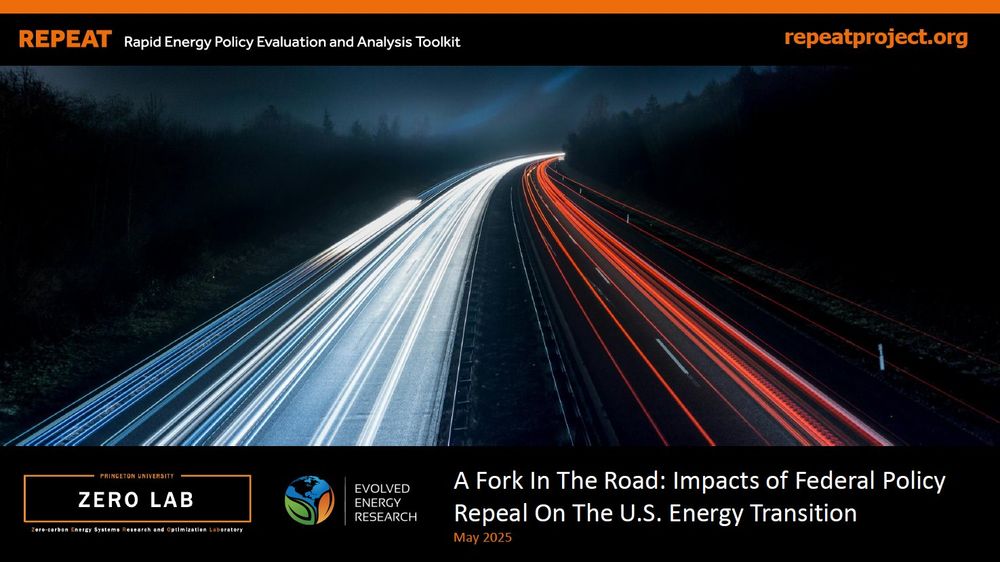
Cover of new REPEAT Project report, "A Fork In The Road: Impacts of Federal Policy Repeal On The U.S. Energy Transition."
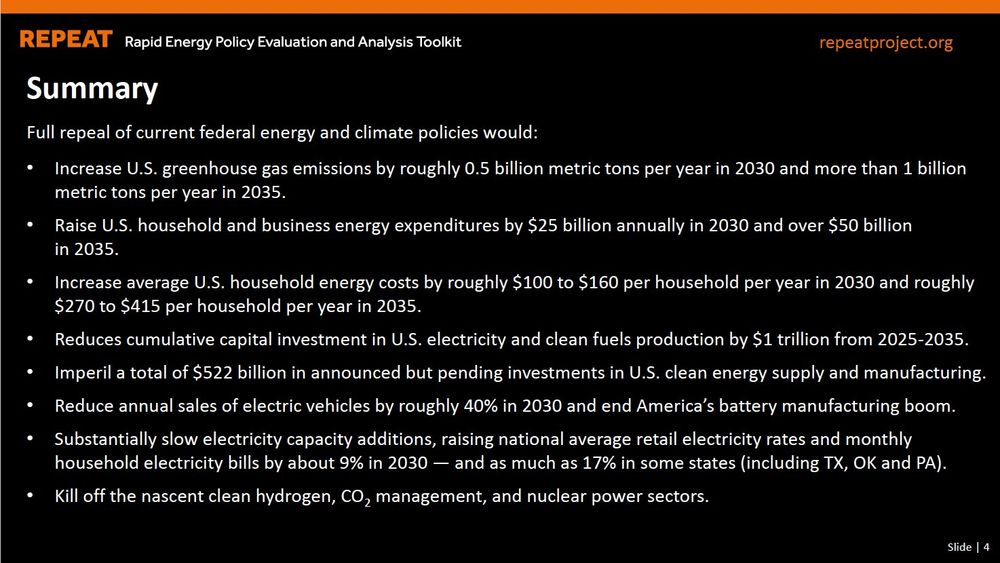
Summary
Full repeal of current federal energy and climate policies would:
• Increase U.S. greenhouse gas emissions by roughly 0.5 billion metric tons per year in 2030 and more than 1 billion
metric tons per year in 2035.
• Raise U.S. household and business energy expenditures by $25 billion annually in 2030 and over $50 billion
in 2035.
• Increase average U.S. household energy costs by roughly $100 to $160 per household per year in 2030 and roughly
$270 to $415 per household per year in 2035.
• Reduces cumulative capital investment in U.S. electricity and clean fuels production by $1 trillion from 2025-2035.
• Imperil a total of $522 billion in announced but pending investments in U.S. clean energy supply and manufacturing.
• Reduce annual sales of electric vehicles by roughly 40% in 2030 and end America’s battery manufacturing boom.
• Substantially slow electricity capacity additions, raising national average retail electricity rates and monthly
household electricity bills by about 9% in 2030 — and as much as 17% in some states (including TX, OK and PA).
• Kill off the nascent clean hydrogen, CO2 management, and nuclear power sectors.
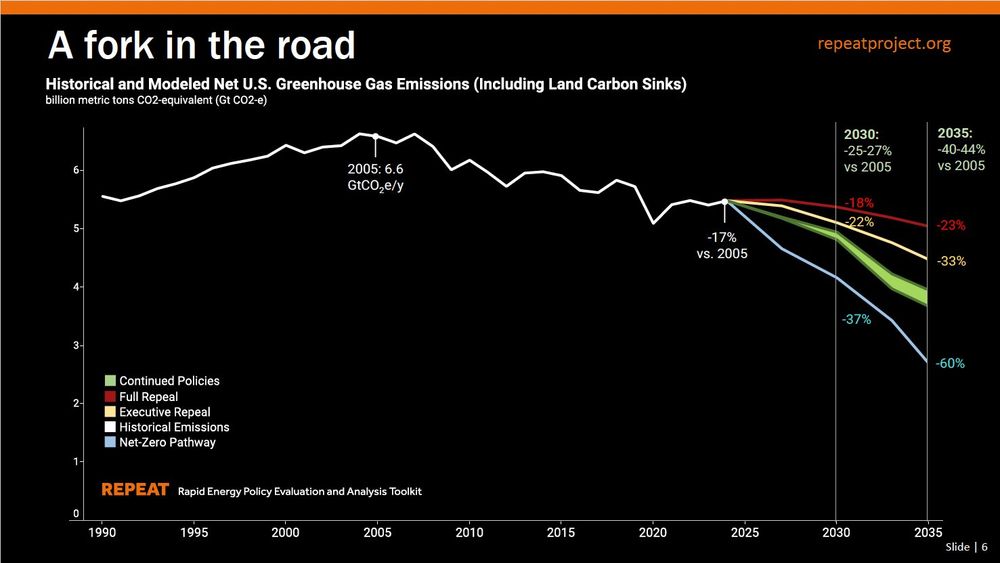
Graphic showing historical and modeled US greenhouse gas emissions, with substantial increase if current federal policies are repealed.
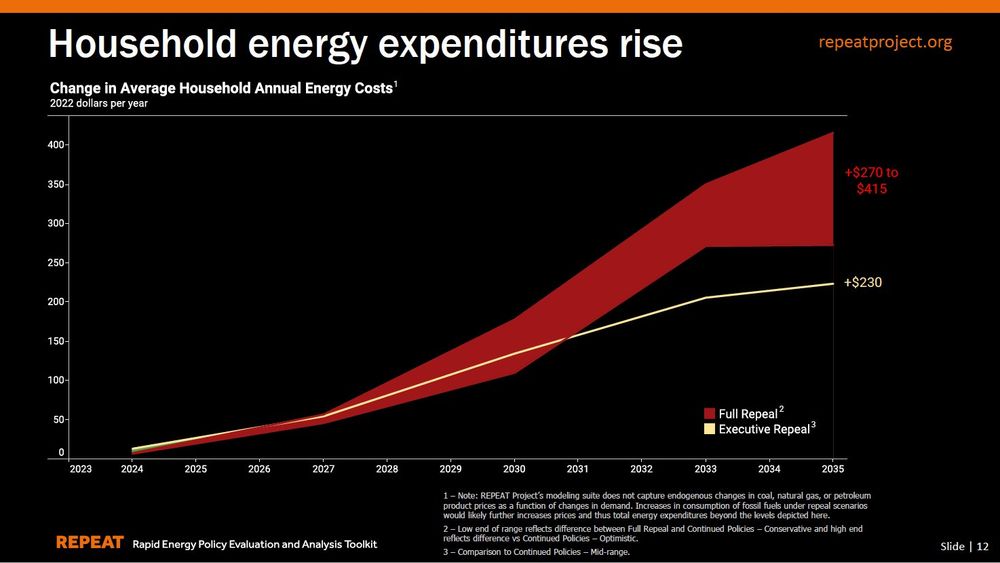
Graphic showing modeled average household US energy costs, with substantial increase if current federal policies are repealed.
What does the GOP Megabill passed by the House this morning mean for the US energy transition, energy prices, emissions and the economy? REPEAT Project's new analysis has you covered. Read the new report or listen to our recent SHIFT KEY episode diving into the details. 🔗 ⤵️
🔌💡
22.05.2025 16:04 — 👍 121 🔁 64 💬 4 📌 16
Yet another reason not to wall ourselves off from competition
25.04.2025 00:05 — 👍 4 🔁 0 💬 0 📌 0
Quite amazing...the US and China are undergoing the energy transition at roughly the same pace.
21.04.2025 14:17 — 👍 2 🔁 0 💬 0 📌 0
This is an excellent idea.
27.03.2025 13:54 — 👍 7 🔁 3 💬 0 📌 0
We are pleased to announce an experiment intended to stimulate academic discussion and exchange, centered on papers published in Econometrica 1/5
27.03.2025 12:36 — 👍 122 🔁 40 💬 2 📌 15
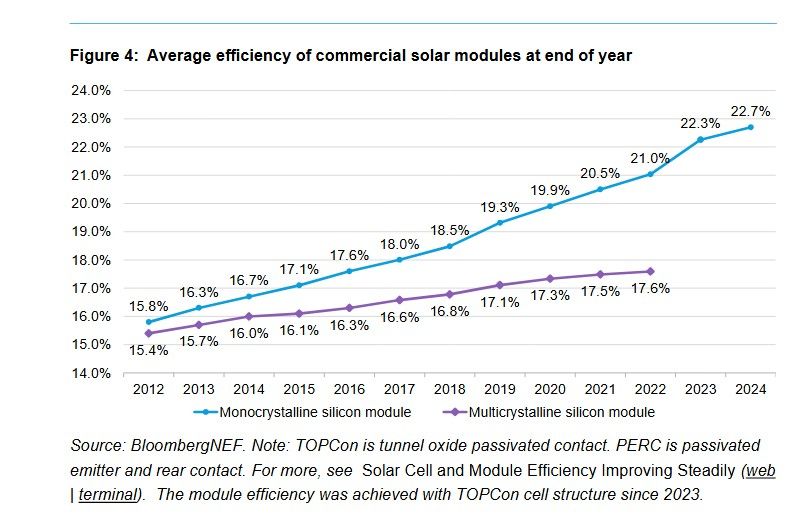
A chart from BloombergNEF showing average efficiency of commercial solar modules at end of year from 2012 to 2024. From 2012 two series are shown, for multicrystalline silicon and monocrystalline silicon. Both increase each year; the multi time series stops in 2022 (due to the product being essentially replaced by mono). The multi efficiency is 15.4% in 2012, and 17.6% in 2022; the mono efficiency is 15.8% in 2012 and 22.7% in 2024.
A typical photovoltaic module sold in 2024 was mono TOPCon with 22.7% efficiency, at a price below $0.10/W.
A typical solar module sold in 2012 was multi AlBSF with efficiency of 15.4% and a price of about $0.87/W.
18.03.2025 11:04 — 👍 98 🔁 23 💬 2 📌 4
That's not right. Measuring fossil fuels by their energy content is wrong, since so much of the energy is wasted. You want electrons delivered, which the link I posted shows.
04.01.2025 08:26 — 👍 0 🔁 0 💬 0 📌 0
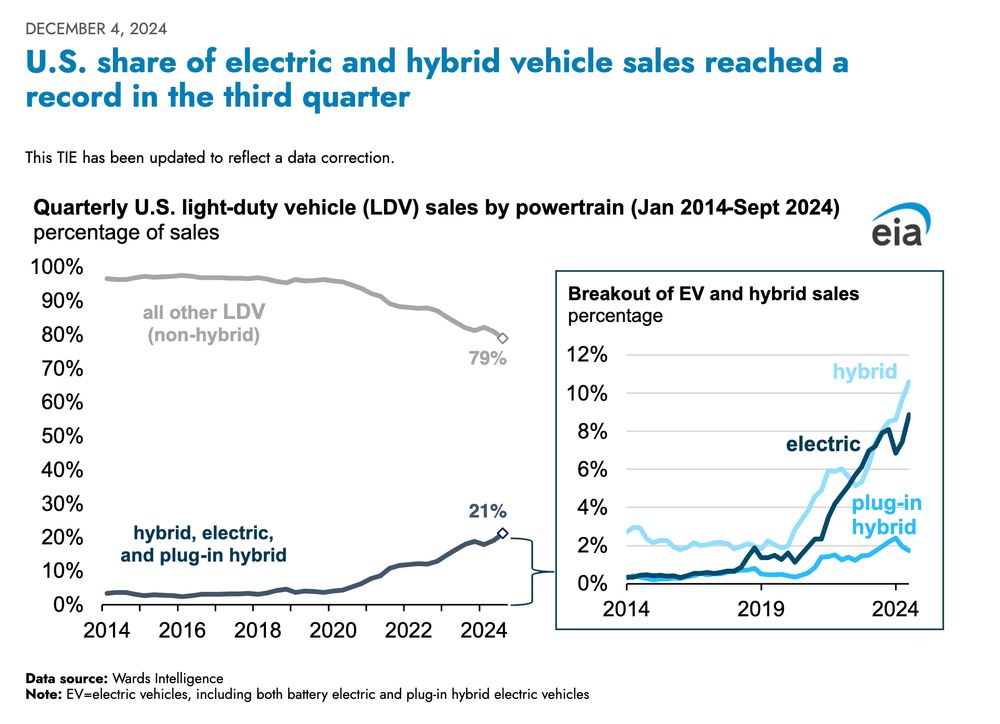
The EV/hybrid transition is continuing in the US. Greater model availability seems to be driving sales.
20.12.2024 22:51 — 👍 5 🔁 0 💬 0 📌 0
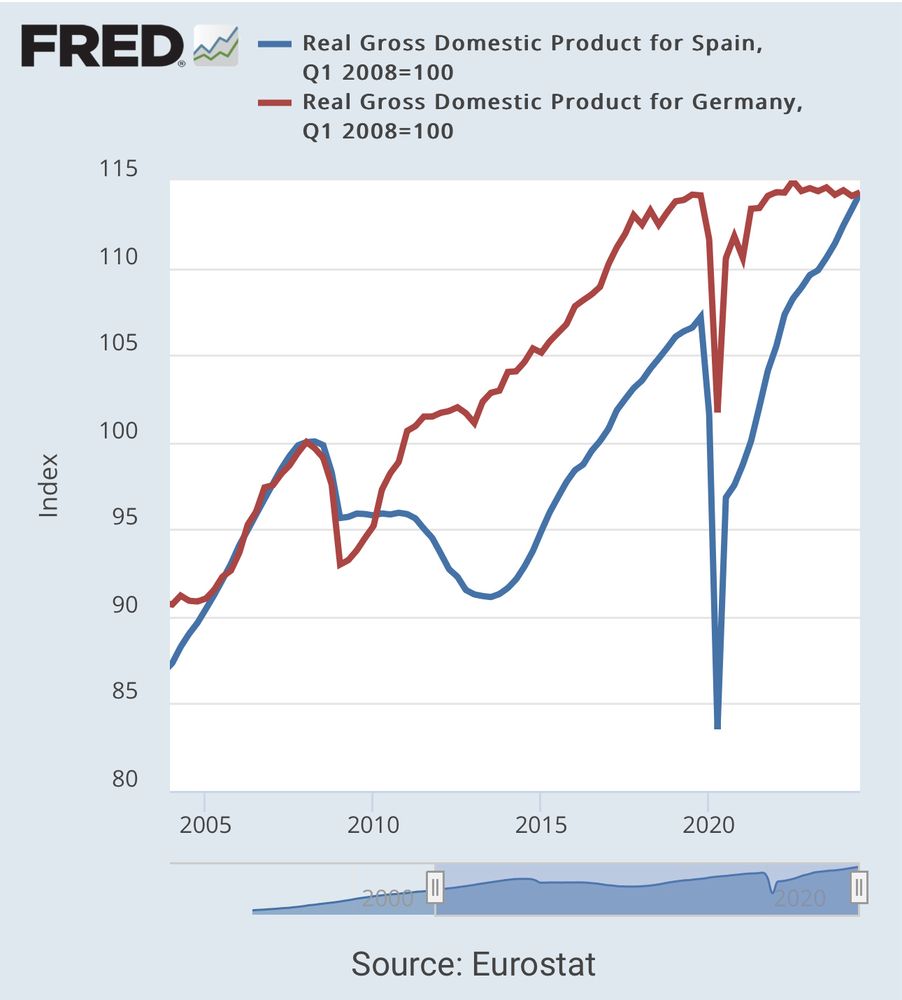
A graph comparing Spanish and German gdp, which diverge in 2008 but reconverge between 2017-2024
Here’s a crazy fact for you: Spain and Germany have now seen basically the exact same amount of economic growth post-2008. Would have been unthinkable to people during most of the 2010s. Spain has seen ~10 percentage points more cumulative growth since 2017.
23.11.2024 09:26 — 👍 1465 🔁 279 💬 50 📌 51
Great overview of a rapidly growing field!
15.11.2024 11:46 — 👍 10 🔁 0 💬 0 📌 0
Make horror gay AF, Stoker Award winner
out now: A GAME IN YELLOW
out now: TEENAGE GIRLS CAN BE DEMONS
she/her; rep: Lane Heymont
haileypiper.com
Former journalist running for Congress (IL-09) because we deserve Democrats who actually do something | katforillinois.com
Assemblymember. Democratic Nominee for Mayor of NYC. Running to freeze the rent, make buses fast + free, and deliver universal childcare. Democratic Socialist. zohranfornyc.com
Support decarbonization, zero-CO2 generation & competitive markets. Former Commissioner of PA PUC, Secretary of PA DEP, Secretary of Policy & Public Advocate for consumers of Philadelphia's municipal utilities. Law degree.
The official Bluesky feed of McSweeney's Quarterly Concern, McSweeney's Internet Tendency, & McSweeney's Books.
.
Econ PhD student at Harvard | Formerly Math + Econ at PUC-Chile.
https://pipeton8.github.io
The Quarterly Journal of Economics is the oldest professional journal of Economics in the English language. Edited by the Department of Economics at Harvard.
Economist. Ex Prof / central banker. Macro, politics, money, central banks, finance, Brexit, covid, AI, climbing, MUFC, list guy, Blueskyism.
🇨🇦 Retired after 40 years at CNR & into astronomy, woodworking, and genealogy. Editor of the RASC Observer's Handbook.🔭 RASC Fellow, Dr (Hons) of astronomy.
Naturalised Australian. Begat from Samoan immigrant parents to New Zealand. Gay man/Fa’afafine. Artist, Drag Performer and Activist. Passionate for the Arts and Human Rights. Atheist until proven otherwise. Freed from Mormonism 🤎🇼🇸🇳🇿🇦🇺🏳️🌈🌈 NO DMS
Artist, metalsmith, blacksmith, dad.
I specialize in historical weapons recreation, but also make tools, melt metals, carve stone and sculpt wood and make art.
I make art to avoid watching the downfall of democracy.
Love to laugh, listen to jazz, and doodle, and watching period movies. Lifelong Democrat. No DM, No Solicitation, No Porn, No maga, No Bio No follow
The official Bluesky account for the Department of Economics at the University at Buffalo
https://arts-sciences.buffalo.edu/economics.html
Pro-housing, pro-abundance, pro-democracy in Northern CA. Housing 🏠, Health ⚕️, Education 📚, & Safety ⛑️ for all. End corruption ⬇️ Get results ⬆️.
Cincy born, Reds, Bengals, Graeters, NU Wildcats, first-time pet owner w/ a very handsome, chill and smart puppy; ok I'm a little biased







